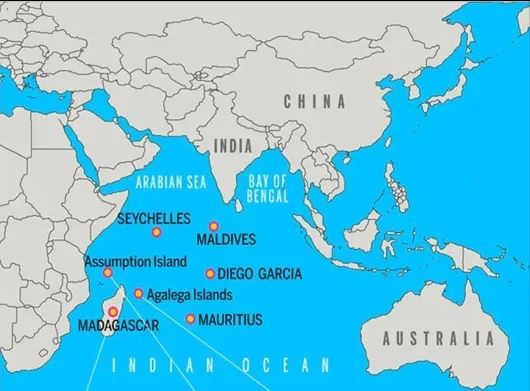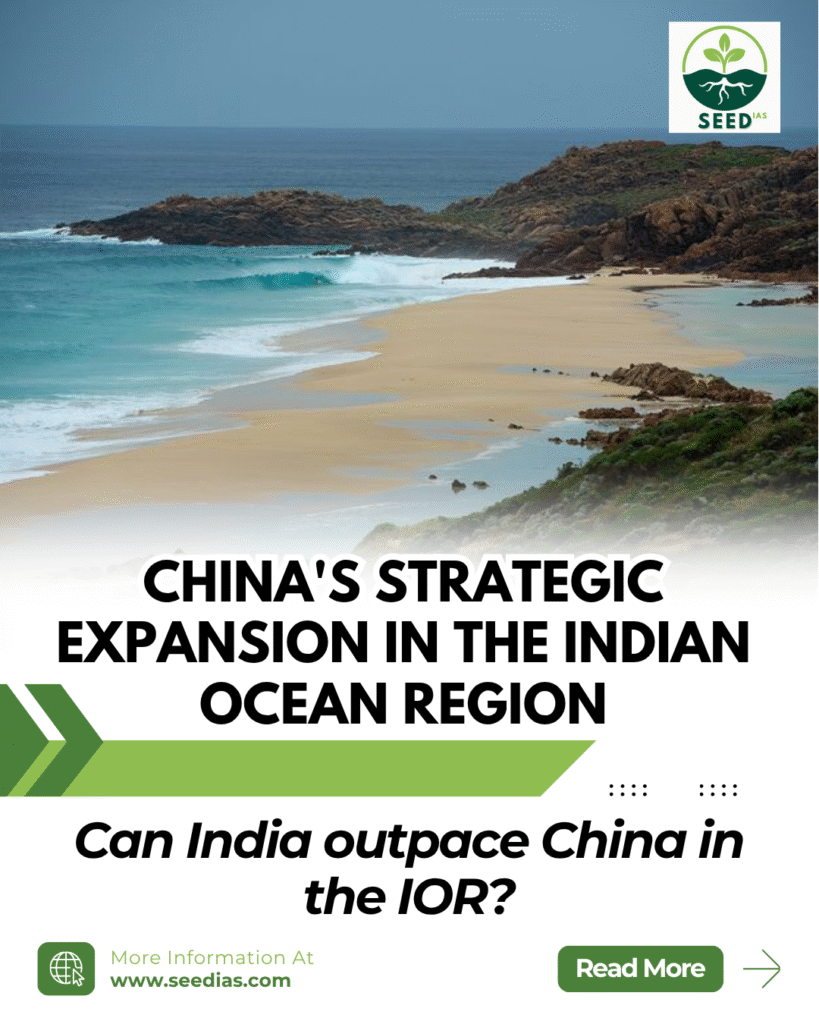Why in NEWS
The Parliamentary Standing Committee on External Affairs flagged China’s increasing strategic foothold in the Indian Ocean Region (IOR) as a major threat to India’s security and regional dominance.
Key Concepts and Terminologies
| Term | Explanation |
|---|---|
| Indian Ocean Region (IOR) | The maritime area surrounding the Indian Ocean, including coastal nations in South Asia, Southeast Asia, Africa, and the Middle East. |
| String of Pearls | China’s strategy of building a network of commercial and military bases in IOR to project power and secure maritime routes. |
| Debt-trap diplomacy | A tactic where China provides high-interest loans for infrastructure and gains control when countries can’t repay. |
| Dual-use infrastructure | Facilities like ports and airports built for civilian use but capable of supporting military operations. |
| IFC-IOR | Information Fusion Centre – Indian Ocean Region, India’s initiative to enhance maritime domain awareness. |
| QUAD | A strategic grouping of India, USA, Japan, and Australia for a free and open Indo-Pacific. |
| Deep Ocean Mission | India’s scientific initiative to explore deep-sea resources using vehicles like Matsya 6000. |

How is China Expanding its Strategic Presence in the Indian Ocean Region?
| Mode of Expansion | Details |
|---|---|
| Dual-Use Ports | Investments in ports like Hambantota (Sri Lanka), Gwadar (Pakistan), Chittagong (Bangladesh), and Kyaukpyu (Myanmar) forming a naval logistics network. |
| Military Presence | Djibouti base (2017), submarine patrols, and use of oceanographic research ships aiding naval operations. |
| Debt Diplomacy | Sri Lanka’s Hambantota lease and Maldives’ loans show how Beijing leverages unsustainable projects for strategic gains. |
| Naval Exercises | Joint drills with Pakistan, Myanmar, Iran, and Russia deepen security ties. |
| Diplomatic Outreach | Establishment of “China-IOR Forum” and political backing for pro-China regimes like President Muizzu of Maldives. |
How China’s Presence Threatens India’s Interests in the IOR
| Area of Threat | Impact on India |
|---|---|
| Military | Surveillance from Coco Islands, deployment of submarines, and possible blockade of key sea lanes like Malacca and Hormuz. |
| Economic | Risk to 80% of oil imports; loss of influence in SAARC, BIMSTEC due to economic dependencies on China. |
| Intelligence | Use of spy ships and undersea sensor networks threatens India’s nuclear submarine secrecy. |
| Geopolitical | China’s growing ties with neighbors could isolate India and increase reliance on external powers. |
| Regional Stability | Potential flashpoints involving QUAD members increase risk of wider conflict in the Indo-Pacific. |
Significance of the Indian Ocean Region for India
| Strategic Interest | Description |
|---|---|
| Security Role | India as a net security provider through INS Vikrant and exercises like MILAN, Malabar, etc. |
| Trade and Energy | 80% of external trade and 90% of energy trade flow through IOR; key for economic growth. |
| Geopolitical Goals | Initiatives like “Act East”, “Neighbourhood First” and outreach to Mauritius, Maldives, Seychelles to counter China. |
| Environment | INCOIS tracks climate threats; India leads CDRI and responds to disasters like Cyclone Idai. |
| Scientific Edge | Missions like Deep Ocean Mission and polymetallic nodule mining boost India’s ocean economy. |
India’s Counter-Strategy to Strengthen its Presence in the IOR
| Domain | Strategy |
|---|---|
| Military | Expand submarine fleet, develop 3rd aircraft carrier, enhance ASW, upgrade ANC with missiles and EW assets. |
| Economic | Push MAHASAGAR policy, promote IMEC as BRI alternative, invest in Chabahar (Iran), Duqm (Oman), Sabang (Indonesia). |
| Diplomatic | Strengthen QUAD, deepen defense ties with France, US, Japan; revitalize IORA and Colombo Security Conclave. |
| Technology | Enhance NAVIC, deploy AI-backed tracking, increase satellite surveillance, counter cyber-espionage. |
| Soft Power | Promote Buddhism, revive ancient sea routes, lead HADR missions, offer education and cultural exchange. |
In a Nutshell (Memory Code: M-POWER)
M – Military upgrades
P – Port investments as BRI counter
O – Ocean surveillance and domain awareness
W – Win over neighbors through soft power
E – Economic corridor IMEC
R – Regional alliances like QUAD and IORA
UPSC Prelims Practice Questions
- Which of the following ports is NOT part of China’s “String of Pearls” strategy?
a) Gwadar
b) Chabahar
c) Hambantota
d) Djibouti - The term “Debt-trap diplomacy” is best associated with:
a) Free trade agreements
b) Military alliances
c) Infrastructure lending practices
d) Cyber surveillance - Consider the following statements:
- IFC-IOR is located in Andaman and Nicobar Islands.
- The String of Pearls theory was proposed by China officially.
Which of the statements is/are correct?
a) Only 1
b) Only 2
c) Both 1 and 2
d) Neither 1 nor 2
Mains Practice Questions
- Analyze the strategic significance of the Indian Ocean Region for India. What steps should India take to ensure security and dominance in the region? (GS Paper 2 – 2023)
- Discuss how China’s growing presence in the Indian Ocean Region challenges India’s strategic interests and regional diplomacy. Suggest counter measures. (GS Paper 2)
Prelims Answer Key and Explanation
| Qn | Answer | Explanation |
|---|---|---|
| 1 | b) Chabahar | Chabahar is developed by India in Iran and not part of China’s strategic chain. |
| 2 | c) Infrastructure lending practices | China uses loans for infrastructure projects that often result in the borrowing country’s economic dependence. |
| 3 | d) Neither 1 nor 2 | IFC-IOR is in Gurugram, Haryana; and String of Pearls is a US strategic analysis, not officially declared by China. |
















